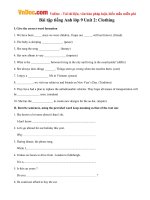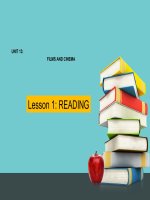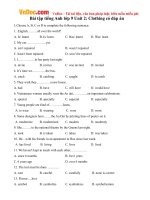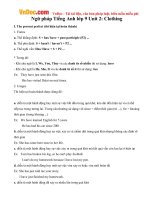Bài giảng môn Tiếng Anh lớp 9 - Unit 2: Clothing (Read)
Bạn đang xem bản rút gọn của tài liệu. Xem và tải ngay bản đầy đủ của tài liệu tại đây (1.59 MB, 16 trang )
READ
Lesson 4:
dress
skirt
Jeans
Short sleeved
blouse
Your favorite
type of clothing.
Colorful T shirt
Blue shorts
Striped shirt
II. New words:
Material (n):
(n):
Cotton
wear out: (v):
Chất liệu, ngun
liBơng, s
ệu
ợi bơng
Làm rách
Ex: She wears out her shirt.
a style:
(to) embroider:
(a) label:
Kiểu dáng
Thêu ( hoa văn, hình ).
Nhãn, nhãn hiệu
IV. Fill in the missing dates and words:_
18th century
jean cloth
1. __________: Workers liked to wear__________
because the material made from cotton was very
strong and could hardly wear out.
1960s
2.______: A lot of university and college _______
students
wore jeans.
1970s
cheaper
3. ______: Jeans became _______ so many, many
people began wearing jeans.
fashion
1980s
4. ______: Jeans became high ________clothing.
1990s
sale
5. ______: The ___ of jeans stopped going up.
1. Where does the word jeans come from ?
The word jeans comes from a kind of
material that was made in Europe.
2. What were the 1960s’ fashions ?
The 1960s’ fashions were embroidered
jeans, painted jeans and so on.
3.Why did more and more people begin wearing
jeans in the 1970s ?
.
Because jeans became cheaper
4.When did jeans at last become high fashion
clothing?
Jeans at last became high fashion
clothing in the 1980s.
5.Why did the sale of jeans stop growing ?
The sale of jeans stopped growing
because the worldwide economic
situation got worse in the 1990s.
* Answer the questions:
1. The word jeans come from a kind of material
that was made in Europe.
2. The 1960s’ fashion were embroidered jeans,
painted jeans and so on.
3. Because jeans became cheaper.
4. Jeans at last became high fashion clothing in
the 1980s.
5. The sale of jeans stopped growing because the
worldwide economic situation got worse in the
1990s.
VI. Homework:
Learn by heart the new words.
Do all the exercises again.
Prepare for: Language Focus
Goodbye students!
Thank you very much
Thank you very much
Thank you very much









